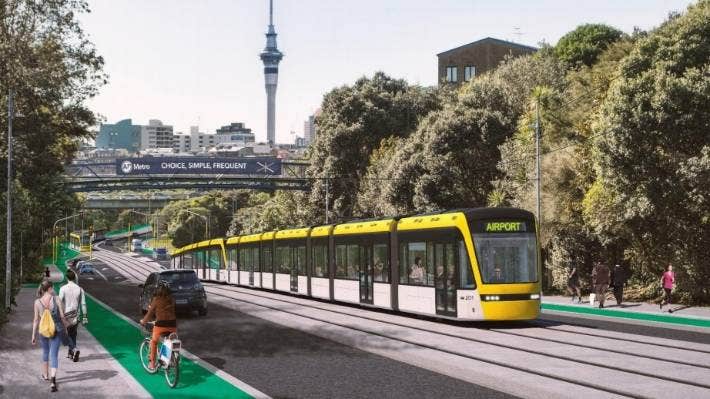Patrick Fontein, Director of Studio D4 and member of Property Council’s Auckland Regional Committee gives his perspective on the Auckland Light Rail project.
The current Government has a very strong focus on its Auckland Light Rail (ALR) project. Public consultation began with nice pictures of trams at street level and a potential budget of $2-5 billion.
By December 2021, the latest ALR scheme was now in 30m deep tunnels, and the current forecast cost had ballooned out to $15Bn. Not that much if you say it quickly, but a lot more once you think about it!
The ALR project, similar to most large public transport projects, is always going to be a political hot potato. So, is there a way that the right of centre could long term support the ALR project? What would the key criteria need to look like?
1. Urban regeneration as the largest priority
Auckland’s isthmus area has a (relatively) very low population density. The areas around the new ALR need a lot more people living within walking distance. With Auckland Council fortitude to up-zone (aided recently by central government’s stick!), we should be targeting at least 60 – 70,000 extra households close to ALR’s stations. Building heights of 6-10 storeys will enable this.
The private sector needs to be encouraged to do the “heavy lifting”, i.e., build most of these higher density properties. How? Ensure most of the up-zoning is in “market attractive” areas; i.e. where many Aucklanders want to live, not pre-dominantly in Kainga Ora owned land areas.
2. Up-zoning has huge benefits for everyone: so “just do it”
Our company was engaged by Auckland Council as a property advisor for the Auckland Plan and Unitary Plan and then by the Independent Hearing Panel in 2010 to 2016. The biggest mis-understood issue involves the economic impact of up-zoning. Having been actively involved in property development for the last 25 years in Auckland, neighbours and affected parties to a development primarily care about only one issue: “how is this project going to affect the value of my property?”
The cold hard facts from the Unitary Plan up-zoning are that:
- Properties up-zoned to Mixed Use increased in value the most (by 2017 – 2018, as a % of 2014 values)
- THAB increased substantially
- Properties in the Single House zone increased in value the least.
Up-zoning enhances property values! Homeowners need to be educated on the economic benefits of having their property up-zoned. Yes, it’s stressful having to re-locate (if you don’t want to live in a high-density area), but economically home-owners will do very well.
3. Pragmatic ALR design; avoid “design by committee”
For the ALR to get widespread support, it needs to be delivered efficiently and cost effectively.
“Too many cooks in the kitchen” and too many wish lists needing to be satisfied has seen massive cost blow outs in other public sector projects. Pragmatism and strong leadership in design will be critical to avoid funding faux pas’ that will stop the ALR from even getting started.
4. Fair payment for ALR, relative to those who will benefit
There will be a large amount of public benefit for the ALR, and this should no doubt be funded by the public sector. If properties are up-zoned substantially and are close to ALR stations, those properties will benefit from the future development opportunities provided by the ALR.
It is fair that properties who receive “value uplift” from the ALR proximity and their up-zoning are taxed in part for this uplift in value, in the form of some sort of levy, paid when up-zoned new property titles issue.
In a “perfect market” a Value Uplift Development Levy would be factored into the (reduced) land price that a build out developer pays the selling landowner. This will only be the case if the Value Uplift Development Levy is well structured and well communicated to all parties in advance.
We also need to consider land taxes to encourage development when an area has had substantial new infrastructure provided (e.g. the ALR) and landowners haven’t re-developed within a set time frame.
5. Effective engagement: The public and private sector intertwined
Property Council has been actively engaging with the ALR team during 2021 and into 2022 and I have been privileged to be included. With all respect to the ALR team, I believe they have been “politely listening”, hearing PCNZ’s detailed reviews and comments, but whether this is making any difference, is yet to be seen.
What we now need is very active engagement from the ALR team and Auckland Council and the best way to demonstrate that is to start with what is currently required of them anyway: substantial up-zoning in the most suitable locations. If this is done well, Auckland will get the quality urban intensification the ALR project envisages.
Author | Patrick Fontein
Director, Studio D4
With over 25 years of experience in property consultancy, development, and investment in Auckland and New Zealand. SD4 has provided property consultancy to Auckland Council and MBIE on growth planning and development capacity modelling.
Patrick is on the Property Council’s Auckland Executive and has been prominent in the organisation’s public sector stakeholder engagement on effective growth planning for several years.


